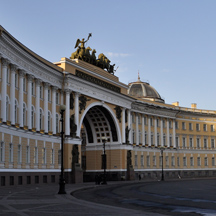
The European Biennial of Contemporary Art
28 June 31 October 2014
St. Petersburg, Russia The State Hermitage Museum
Concept
Manifesta 10 will be in the Hermitage Museum on the Neva River in central St. Petersburg, Russia. The Manifesta Biennial was inspired by the changing European constellation of 1989-91, and was initiated in order to take advantage and expand upon the increased artistic exchange made possible by these events. Now Manifesta will look back and take stock. St. Petersburg is suited for this reflection because of its former status as cultural capital of Russia and “gateway” to the West. The uniqueness of the Hermitage—a palace complex with extraordinary collections and inspired visitors—lends itself in a most unusual way to looking at varied moments in art history (local and global, recent and archaic). Manifesta 10 will explore gaps, propose ways to take advantage of them, and encourage personal aesthetic experience among the social buzz of the visitors.
In order to bring together the newly renovated and restored General Staff Building, which will house two-thirds of Manifesta 10, and the Winter Palace, which will hold one-third, we have agreed to interchange parts of the historical collections and Manifesta 10 works between the two buildings. It is important to work in surprising ways with the contrast between the opulent palace halls and the whole series of modern spaces. These spaces are separated by the paved expanse of Palace Square, rendering it necessary to create a visual connection between them through artwork. It is of primary importance to activate the overall complex and bring the various parts into a more explicit relationship with each other through the visitor. It is a central idea that, from time to time, contemporary art should be experienced in dialogue with art from other periods and cultures.
The General Staff Building’s new spaces for modern and contemporary art are more simple and less adorned than the Winter Palace interiors. The exhibition and public program artists were sought out for their strong positions and their international relevance. While some link political and social statements to their work, there is no such prerequisite for consideration; others are chosen with the aspect of critique in mind, or for reasons pertaining solely to artistic discussion and development.
Broadening the reach of Manifesta within the Hermitage will increase its impact. Both visitors who stroll through the Winter Palace in order to experience the glamour of the palace and see art, and those visitors who come especially for Manifesta, will be exposed to something beyond their intended horizons and can ponder the interrelationship of history and the present. The installation strategy for the Winter Palace IS crucial to this plan. A number of galleries there have been selected to show contemporary art.
St. Petersburg’s mainstream art scene is relatively conservative, oriented toward the canon of academic art and major moments of the classical modern. We are trying to avoid the inflationary tendencies of the current global art scene and re trying, in a playful way, to find out what is needed in this context and what is plausible and challenging within the Hermitage. We hope to attract visitors to Manifesta 10 for whom it will be an initial first-hand experience with contemporary art.
The exhibition includes a relatively modest number of artists represented by several works each, rather than offering an encompassing overview of contemporary art. As a guest, we very much enjoy working with colleagues at the Hermitage and are aware of how big and extraordinary a challenge it is: bringing contemporary art into a unique universal museum, such as the Hermitage.
Brief Concept MANIFESTA 10 by Kasper König






